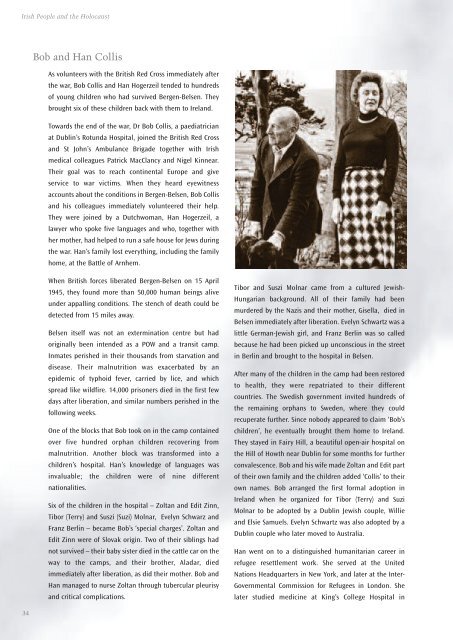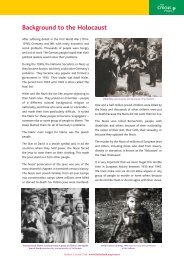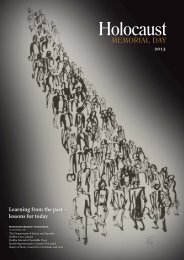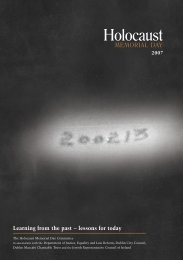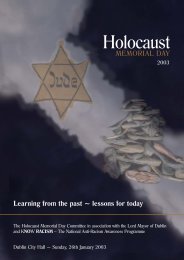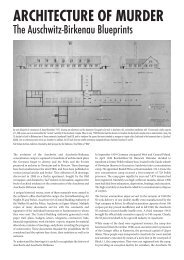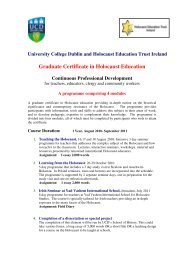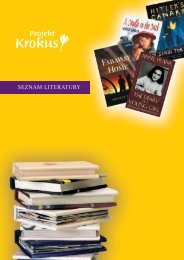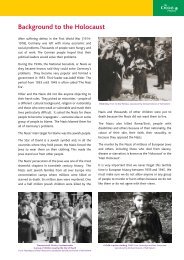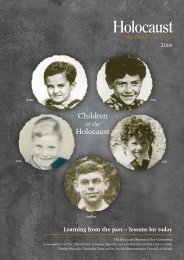Learning from the past ~ lessons for today - Holocaust Education ...
Learning from the past ~ lessons for today - Holocaust Education ...
Learning from the past ~ lessons for today - Holocaust Education ...
You also want an ePaper? Increase the reach of your titles
YUMPU automatically turns print PDFs into web optimized ePapers that Google loves.
Irish People and <strong>the</strong> <strong>Holocaust</strong><br />
Bob and Han Collis<br />
As volunteers with <strong>the</strong> British Red Cross immediately after<br />
<strong>the</strong> war, Bob Collis and Han Hogerzeil tended to hundreds<br />
of young children who had survived Bergen-Belsen. They<br />
brought six of <strong>the</strong>se children back with <strong>the</strong>m to Ireland.<br />
Towards <strong>the</strong> end of <strong>the</strong> war, Dr Bob Collis, a paediatrician<br />
at Dublin’s Rotunda Hospital, joined <strong>the</strong> British Red Cross<br />
and St John’s Ambulance Brigade toge<strong>the</strong>r with Irish<br />
medical colleagues Patrick MacClancy and Nigel Kinnear.<br />
Their goal was to reach continental Europe and give<br />
service to war victims. When <strong>the</strong>y heard eyewitness<br />
accounts about <strong>the</strong> conditions in Bergen-Belsen, Bob Collis<br />
and his colleagues immediately volunteered <strong>the</strong>ir help.<br />
They were joined by a Dutchwoman, Han Hogerzeil, a<br />
lawyer who spoke five languages and who, toge<strong>the</strong>r with<br />
her mo<strong>the</strong>r, had helped to run a safe house <strong>for</strong> Jews during<br />
<strong>the</strong> war. Han’s family lost everything, including <strong>the</strong> family<br />
home, at <strong>the</strong> Battle of Arnhem.<br />
When British <strong>for</strong>ces liberated Bergen-Belsen on 15 April<br />
1945, <strong>the</strong>y found more than 50,000 human beings alive<br />
under appalling conditions. The stench of death could be<br />
detected <strong>from</strong> 15 miles away.<br />
Belsen itself was not an extermination centre but had<br />
originally been intended as a POW and a transit camp.<br />
Inmates perished in <strong>the</strong>ir thousands <strong>from</strong> starvation and<br />
disease. Their malnutrition was exacerbated by an<br />
epidemic of typhoid fever, carried by lice, and which<br />
spread like wildfire. 14,000 prisoners died in <strong>the</strong> first few<br />
days after liberation, and similar numbers perished in <strong>the</strong><br />
following weeks.<br />
One of <strong>the</strong> blocks that Bob took on in <strong>the</strong> camp contained<br />
over five hundred orphan children recovering <strong>from</strong><br />
malnutrition. Ano<strong>the</strong>r block was trans<strong>for</strong>med into a<br />
children’s hospital. Han’s knowledge of languages was<br />
invaluable; <strong>the</strong> children were of nine different<br />
nationalities.<br />
Six of <strong>the</strong> children in <strong>the</strong> hospital – Zoltan and Edit Zinn,<br />
Tibor (Terry) and Suszi (Suzi) Molnar, Evelyn Schwarz and<br />
Franz Berlin – became Bob’s ‘special charges’. Zoltan and<br />
Edit Zinn were of Slovak origin. Two of <strong>the</strong>ir siblings had<br />
not survived – <strong>the</strong>ir baby sister died in <strong>the</strong> cattle car on <strong>the</strong><br />
way to <strong>the</strong> camps, and <strong>the</strong>ir bro<strong>the</strong>r, Aladar, died<br />
immediately after liberation, as did <strong>the</strong>ir mo<strong>the</strong>r. Bob and<br />
Han managed to nurse Zoltan through tubercular pleurisy<br />
and critical complications.<br />
Tibor and Suszi Molnar came <strong>from</strong> a cultured Jewish-<br />
Hungarian background. All of <strong>the</strong>ir family had been<br />
murdered by <strong>the</strong> Nazis and <strong>the</strong>ir mo<strong>the</strong>r, Gisella, died in<br />
Belsen immediately after liberation. Evelyn Schwartz was a<br />
little German-Jewish girl, and Franz Berlin was so called<br />
because he had been picked up unconscious in <strong>the</strong> street<br />
in Berlin and brought to <strong>the</strong> hospital in Belsen.<br />
After many of <strong>the</strong> children in <strong>the</strong> camp had been restored<br />
to health, <strong>the</strong>y were repatriated to <strong>the</strong>ir different<br />
countries. The Swedish government invited hundreds of<br />
<strong>the</strong> remaining orphans to Sweden, where <strong>the</strong>y could<br />
recuperate fur<strong>the</strong>r. Since nobody appeared to claim ‘Bob’s<br />
children’, he eventually brought <strong>the</strong>m home to Ireland.<br />
They stayed in Fairy Hill, a beautiful open-air hospital on<br />
<strong>the</strong> Hill of Howth near Dublin <strong>for</strong> some months <strong>for</strong> fur<strong>the</strong>r<br />
convalescence. Bob and his wife made Zoltan and Edit part<br />
of <strong>the</strong>ir own family and <strong>the</strong> children added ‘Collis’ to <strong>the</strong>ir<br />
own names. Bob arranged <strong>the</strong> first <strong>for</strong>mal adoption in<br />
Ireland when he organized <strong>for</strong> Tibor (Terry) and Suzi<br />
Molnar to be adopted by a Dublin Jewish couple, Willie<br />
and Elsie Samuels. Evelyn Schwartz was also adopted by a<br />
Dublin couple who later moved to Australia.<br />
Han went on to a distinguished humanitarian career in<br />
refugee resettlement work. She served at <strong>the</strong> United<br />
Nations Headquarters in New York, and later at <strong>the</strong> Inter-<br />
Governmental Commission <strong>for</strong> Refugees in London. She<br />
later studied medicine at King’s College Hospital in<br />
34


